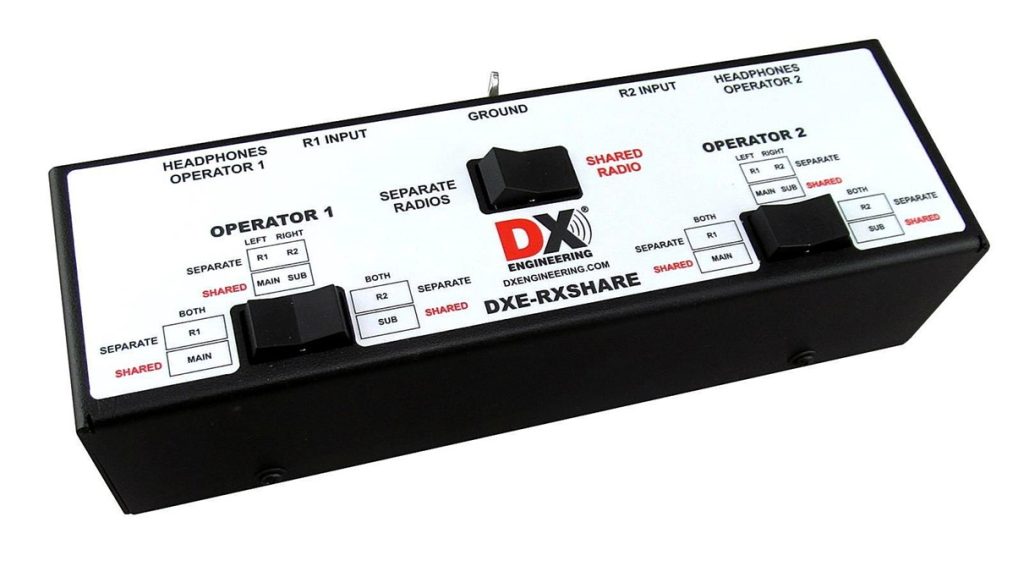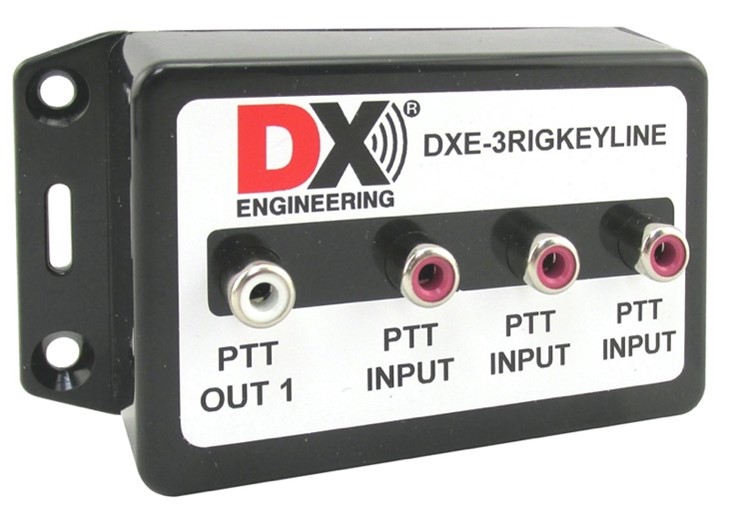Mom always said to share. That’s good advice, even for hams. But what if sharing is a pain—plugging and unplugging, moving connections, or constantly rewiring to coordinate your station?
Sure, you’ve used a coaxial A/B switch or a headphone splitter. But did you know there are more advanced options, like antenna switches that automatically make choices based on band information provided by your transceiver? Or how about multiple switching options in one box—any of three transceivers can be matched with six antennas, and the combination automatically connected to a linear amplifier?
There’s updated technology available that will help you efficiently share connections, direct audio feeds, or even help you comply with contesting rules. Here are a few examples.
Traffic Control
Multi-operator contesting is challenging, especially when a pair of operators are unable to hear what the other operator is hearing. DX Engineering has a simple solution with the DXE-RXSHARE Audio Switch, a flexible device that allows two operators to hear exactly what they want to hear, whenever they want to hear it. Audio from two separate radios or one shared radio can be controlled by either operator’s three-position rocker switch to choose the audio they want fed to their stereo headphones.

With the RXSHARE placed between both operators, selections can be changed independently at will, quickly and easily on the fly. The RXSHARE has been field tested and used in competition by experienced, world-class contesters. Multi-operator contesting in the “Multi-Two” or “Multi-Single” category often involves simultaneous use of separate radios on a single band or on two different bands.
SO2R (Single-Op, 2 Radios) mode has similar needs. The operator may want to focus on just one of the radios, listening to the same audio in both ears. Or the operator can hear the audio from each radio in one ear, allowing simultaneous CQing and tuning for new contacts.
When one radio is shared by two operators, common during Field Day or training activities, the RXSHARE is placed in the SHARED RADIO mode. Both operators can share the received audio, or audio from a sub-receiver, if available, can be selected by either operator. The RXSHARE provides a convenient way of splitting the audio output of a single radio.
Audio from typical radio headphone jacks to the RXSHARE input phone jacks are connected with user-supplied patch cables with 1/4 inch (6.35 mm) stereo phone plugs at each end. The unit features two sets of stereo headphone outputs including 1/4 inch (6.35 mm) and 1/8 inch (3.5mm) stereo jacks to accommodate headphones or headsets with either type of plug. Audio levels are controlled by the transceiver AF Gain controls.
Switch Things Up
You’ve got several transceivers and want to use a single amp for them all. The DX Engineering Key Line Combiner, DXE-3RIGKEYLINE, is another handy gadget that can take the ground-on-transmit amplifier keying lines from up to three transceivers or other devices and connect them to one amplifier or accessory. While a coax switch handles the RF, the Key Line Combiner handles the PTT keying without using a manual switch.

Each keying input of this device is guarded with a separate 45V 2A Schottky diode, providing ground-on-transmit isolation between each rig keying line. So no worries—this combiner will keep the load or voltage of any one device from affecting the others. This device requires no power (it is not a transistor buffer and has no relays).
Several variations of this combiner are available from DX Engineering. There’s a two-input, two-output combiner-splitter (DXE-KEYLINE-DUAL) and a Transceiver Key Line Splitter (DXE-KEYLINE-3)—a single-input, triple-output passive DC only device that provides PTT keying lines, two for other accessories and one for the amplifier.
Unleash Your Power
Does your power supply system look like a twisted pile of black and red spaghetti? Get rid of that mess with a West Mountain Radio RIGrunner DC Outlet Panel.
RIGrunners are available with four to 12 outlets, equipped with Anderson Powerpole outlets positioned horizontally or vertically on the bar for easy access. All are capable of handling up to 40 amps of total output current, and each outlet is individually fused for protection. Think of it as the 12 volt equivalent of an AC power panel for your radio gear.
Some RIGrunners also have advanced features, such as automatic power-on detection, USB charging ports, DC-power monitoring indicators, programmable automatic trip points, and Internet reporting. RF suppression on each outlet blocks RF leakage between equipment.
Fair Share
The EA4TX Interlock Contest Device helps you follow amateur radio contest rules for participation in multi-operator categories. The EA4TX Interlock supports five radios (R1, R2, R3, R4, and R5) and can be configured as M/S or M/2 so the unit will monitor that only one (M/S) or two (M/2) signals are on air. In case of an inadvertent rules violation, this unit activates an inhibit signal that will be used by the connected radio to stop the unwanted transmission.
Yaesu and Elecraft K3 radios are built to accept this inhibit signal and are easily connected to the interlock using optional Yaesu and Elecraft K3 cables available from DX Engineering. Other radio brands that do not have internal support of the inhibit signal may be controlled by means of a relay that will interrupt the Mic PTT line. This is explained in the manual, accompanied by a schematic.
Antenna Swap
Sooner or later, your antenna farm will sprout several additional antennas. DX Engineering’s RR8B Remote Antenna Switch and Control Console Packages let you quickly switch among antennas and will save you money on coaxial cable as well. Connect each antenna to one of eight available remote unit ports and send only one coax line back to your shack.
These packages combine DX Engineering’s 5 or 10 kW key-down switch feature, plus a CC-8A or EC-8 Control Console. RR8B series Remote Antenna Switches come with built-in lightning protection—unused antenna ports are open by design and may be internally jumpered to be grounded when not selected. They’re fully RF-shielded with a high-strength, UV-resistant cover, plus come with a stainless steel mounting bracket and hardware.
If you already have multiple coax lines running to your shack, the Hamplus AS-603AL Automatic Antenna Switch could be your solution. These are actually two smart switches combined, one for three radios and one for six antennas, plus they have rear panel ports for an amplifier or filter set to be used in between. Only the selected radio port has access to the selected antenna; unused antennas are automatically grounded. Illuminated and easily labeled buttons let you know exactly which radio is connected to which antenna at a glance.
The AS-603AL is also an automatic smart switch. Connecting with an optional interface cable to each radio, it uses frequency data from COM, CAT or CI-V enabled transceivers. The selected radio’s frequency information is read by the AS-603, which automatically switches to the last memorized antenna port selection for that frequency range. This means completely different antennas that properly cover different band segments are easily and automatically selected by simply changing the frequency on the radio or even by selecting a different radio.
Share and Share a Mic
The MFJ 1263 Microphone Control Center lets you mix and match any two microphones to any two transceivers. It works with any radio—Kenwood, Yaesu, Icom, Alinco or other compatible transceiver—using an 8-pin round or modular microphone jack. Internal jumpers configure the control center for your radio so your favorite mics never become obsolete!
You can change microphones by pushing a button, instantly switching from a HiFi rag-chew mic to a hard-hitting DX mic when a rare one suddenly pops up. An input jack and on/off switch are also provided to insert external audio into the microphone audio input line. It is great for adding a sound card, SSTV, AFSK, TNC, and other audio sources.
You can add a PTT footswitch or let your computer or voice keyer control your PTT line to free your hands for contesting and DXing. Plug in a boom mic/headset to improve copy in a noisy environment such as during Field Day or multi-operator contesting.

